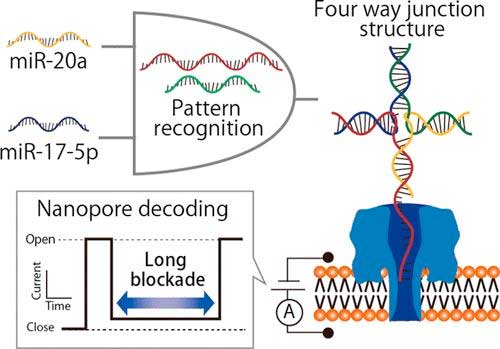| Posted: Oct 05, 2018 | |
Nanopore technology with DNA computing easily detects microRNA patterns of lung cancer(Nanowerk News) Small Cell Lung Cancer (SCLC) is very aggressive, since the cancer cells not only quickly grow but also easily spread to entire body. Often SCLC can be diagnosed using several common tests unfortunately after spread of cancer cells, resulting in poor survival. |
|
| Now researchers at Tokyo University of Agriculture and Technology (TUAT) in Japan have developed a simple technique to sufficiently identify SCLC earlier. | |
| This work, published in the journal Analytical Chemistry ("DNA Logic Operation with Nanopore Decoding To Recognize MicroRNA Patterns in Small Cell Lung Cancer"), presented how nanopore technology was combined with DNA computing technology to catch the early biomarkers for SCLC, which were two independent microRNAs. | |
 |
|
| DNAs autonomously recognized two microRNAs, miR-20a and miR-17-5p, and formed a four-way junction structure that was captured in the nanopore, showing long blocking currents. | |
| "DNA computing technology allows DNA molecules to autonomously recognize the pattern of microRNA molecules (input) and to convey (output) the information, which this case electric current was generated", said senior author Dr. Ryuji Kawano, Associate Professor, Department of Biotechnology and Life Science, TUAT. | |
| Those microRNAs (miR-20a and miR-17-5p) are known to be the biomarkers for SCLC and are secreted in patients. | |
| "We designed diagnostic DNAs artificially and developed a nanopore device that independently recognized those microRNAs through microdroplets," said Dr. Kawano. | |
| The diagnostic DNAs recognized the two microRNAs and formed the complex structure of microRNA and diagnostic DNA autonomously (See Image). In the case of the both miR-20a and miR-17-5p are simultaneously present, or there is only one, or when neither exists, (1 1), (1 0) or (0 1), or (0 0), respectively, all different cases were discriminated by the duration of the blocking current signals without labeling. This measurement can be conducted around for 1 hour. | |
| Compared to cell biopsy, liquid biopsy has been recently more attracted due to minimally invasive method for early cancer detection. This result gives the possibility of next generation diagnosis for cancer-specific diagnosis from body fluids. | |
| The researchers are applying this technique to real body fluids. |
| Source: Tokyo University of Agriculture and Technology | |
|
Subscribe to a free copy of one of our daily Nanowerk Newsletter Email Digests with a compilation of all of the day's news. |
